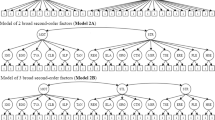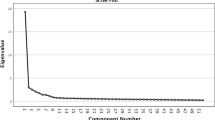Abstract
The underlying structure of the Revised Two factor version of the Study Process Questionnaire (R-SPQ-2F), a 20-item instrument for the evaluation of students’ approaches to learning (SAL), was examined at item level using two independent groups of undergraduate students enrolled in the first (n=314) and last (n=522) years of their studies. The methods used were (a) Exploratory factor analysis (EFA) assisted by rigorous procedures such as Velicer’s MAP test, parallel analysis and the Schmid Leiman solution with the first sample; and (b) confirmatory factor analysis (CFA) with the second sample. The results of EFA indicated that the latent structure of the R-SPQ-2F is best described by two factors and the results of CFA suggested that out of four a priori structural models, the best fit was achieved by a simple first-order two-factor model. Taken together, these results seemed to converge, suggesting (a) that SAL might be defined as a co-variation between a motive and its intended strategy, these not necessarily being divided into separate first-order factors (subscales), and (b) that the underlying structure of the R-SPQ-2F is apparently non-hierarchical, being best described by a parsimonious first-order two-factor model in which Deep and Surface learning approaches are each measured by their ten corresponding items.
Résumé
La structure sous-jacente de la versión révisée de deux facteurs du Questionnaire de Processus de l’Étude (R-SPQ-2F), un instrument comprenant 20 items pour l’évaluation des approches d’apprentissage des étudiants (SAL), a été examinée en se basant sur les ítems et en utilisant deux échantillons indépendants d’étudiants qui faisaient leur première (n=314) et leur dernière (n=522) année d’études. Les méthodes utilisées ont été (a) l’analyse factorielle exploratoire (AFE) à l’aide de procedés rigoureux tels que le test MAP de Velicer, l’analyse parallèle et la solution de Schmid-Leiman avec le premier échantillonnage; et (b) l’analyse factorielle confirmative (AFC) avec le deuxième échantillonnage. Les résultats de l’AFE ont montré que la meilleure structure latente du R-SPQ-2F fut celle décrite par deux facteurs, et les résultats de l’AFC ont suggéré que des quatre modèles structuraux proposés, le meilleur ajustage a été réussi à partir d’un simple modèle de deux facteurs de premier ordre. Pris dans l’ensemble, ces résultats semblaient converger en suggérant (a) que les SAL peuvent être définis comme une covariation entre un motif et sa stratégie correspondante, pas nécessairement divisés en facteurs de premier ordre (sous-échelles) indépendants, et (b) que la structure sous-jacente de l’R-SPQ-2F n’est apparement pas hiérarchique, sa meilleur description étant un modèle de deux facteurs de premier ordre où les approches Profonde et Superficielle sont mésurées à partir des 10 items correspondants.
Similar content being viewed by others
References
Biggs, J. (1978). Individual and group differences in study process.British Journal of Educational Psychology, 48, 266–279.
Biggs, J. (1987a).Student Approaches to Learning and Studying. Melbourne: Australian Council for Educational Research.
Biggs, J. (1987b).Study Process Questionnaire: Manual. Melbourne: Australian Council for Educational Research.
Biggs, J. (1987c).Learning Process Questionnaire: Manual. Melbourne: Australian Council for Educational Research.
Biggs, J. (1993). What do inventories of students’ learning processes really measure? A theoretical review and clarification.British Journal of Educational Psychology, 63, 1–17.
Biggs, J. (2001). Enhancing learning: A matter of style or approach? In R.J. Sternberg & L.F. Zhang (Eds.),Perspectives on thinking, learning, and cognitive styles (pp. 73–102). Mahwah, NJ: Lawrence Erlbaum Associates, Publishers.
Biggs, J., Kember, D., & Leung (2001). The revised two-factor Study Process Questionnaire: R-SPQ-2F.British Journal of Educational Psychology, 71, 133–149.
Bollen, K.A. (1989).Structural equations with latent variables. New York: John Wiley and Sons.
Burnet, P.C., & Dart, B.C. (2000). The Study Process Questionnaire: A construct validation study.Assessment & Evaluation in Higher Education, 25, 93–99.
Cano, F. (2005). Consonance and dissonance in students’ learning experience.Learning and Instruction, 15, 201–223.
Christensen, C.A., Massey, D.R., & Isaacs, P.J. (1991). Cognitive strategies and study habits: An analysis of the measurement of tertiary students’ learning.British Journal of Educational Psychology, 61, 290–299.
Entwistle, N., & McCune, V. (2004). The conceptual basis of study strategy inventories.Educational Psychology Review, 16, 325–345.
Entwistle, N., Tait, H., & McCune, V. (2000). Patterns of response to an approaches to studying inventory across contrasting groups and contexts.European Journal of Psychology of Education, 15(1), 33–48.
Flora, D.B., Finkel, E.J., & Foshee, V.A. (2003). Higher order factor structure of a self-control test: Evidence from confirmatory factor analysis with polychoric correlations.Educational and Psychological Measurement, 63, 112–127.
Fox, R.A., McManus, I.C., & Winder, B.C. (2001). The shortened Study Process Questionnaire: An investigation of its structure and longitudinal stability using confirmatory factor analysis.British Journal of Educational Psychology, 71, 511–530.
Gorsuch, R.L. (1983).Factor analysis (2nd ed.) Hillsdale, NJ: Erlbaum.
Hattie, J., & Watkins, D. (1981). Australian and Filipino investigations of the internal structure of Biggs’ new Study Process Questionnaire.British Journal of Educational Psychology, 51, 241–244.
Henson, R.K., & Roberts, J.K. (2006). Use of exploratory factor analysis in published research. Common errors and some comment on improved practice.Educational and Psychological Measurement, 66, 393–416.
Horn, J.L. (1965). A rationale and test for the number of factors in factor analysis.Psychometrika, 30, 179–185.
Jöreskog, K.G. (1994). On the estimation of polychoric correlations and their asymptotic covariance matrix.Psychometrika, 59, 381–389.
Jöreskog, K.G., & Sörbom, D. (1996a).LISREL 8: User’s reference guide. London: Sage.
Jöreskog, K.G., & Sörbom, D. (1996b).PRELIS 2: User’s reference guide. London: Sage.
Kaiser, H.F. (1960). The application of electronic computers to factor analysis.Educational and Psychological Measurement, 20, 141–151.
Kelloway, K. (1998).Using LISREL for structural equation modeling: A researchers’ guide. Thousand Oaks, CA: Sage Publications, Inc.
Kember, D., & Gow, L. (1990). Cultural specificity of approaches to study.British Journal of Educational Psychology, 60, 356–363.
Kember, D., & Leung, D.Y.P. (1998). The dimensionality of approaches to learning: An investigation with confirmatory factor analysis on the structure of the SPQ and the LPQ.British Journal of Educational Psychology, 68, 395–407.
Kember, D., Wong, A., & Leung, D.Y.P. (1999). Reconsidering the dimensions of approaches to learning.British Journal of Educational Psychology, 69, 323–343.
Kline, R.B. (1998).Principles and practice of structural equation modelling. New York: Guilford Press.
Marton, F., & Säljö, R. (1976a). On qualitative differences in learning. I — Outcome and process.British Journal of Educational Psychology, 46, 4–11.
Marton, F., & Säljö, R. (1976b). On qualitative differences in learning. I — Outcome as a function of the learner’s conception of the task.British Journal of Educational Psychology, 46, 115–127.
Meyer, J.H.F., & Eley, M.G. (2006). The Approaches to Teaching Inventory: A critique of its development and aplicability.British Journal of Educational Psychology, 76, 633–649.
Meyer, J.H.F., & Parsons, P. (1989). Approaches to studying and course perceptions using the Lancaster Inventory-a comparative study.Studies in Higher Education, 14, 137–153.
O’Connor, B. (2000) SPSS and SAS programs for determining the number of components using parallel analysis and Velicer’s MAP test.Behavior Research Methods, Instruments & Computers, 32, 396–402.
O’Neil, M.J., & Child, D. (1984). Biggs’ SPQ: A British study of its internal structure.British Journal of Educational Psychology, 54, 228–234.
Prosser, M., Trigwell, K., Hazel, E., & Waterhouse, F. (2000). Students’ experiences of studying physics concepts: The effects of disintegrated perceptions and approaches.European Journal of Psychology of Education, 15(1), 61–74.
Rodríguez, L., & Cano, F. (2006). The epistemological beliefs, learning approaches and study orchestrations of university students.Studies in Higher Education, 31, 617–636.
Richardson, J.T.E. (2000).Researching student learning Approaches to studying in campus-based and distance education. Buckingham: SRHE & Open University Press.
Richardson, J.T.E. (2004). Methodological issues in questionnaire-based research on student learning in higher education.Educational Psychology Review, 16, 347–358.
Rindskopf, D., & Rose, T. (1988). Some theory and applications of confirmatory second-order factor analysis.Multivariate Behavioural Research, 23, 51–67.
Russell, D.W. (2002). In search of underlying dimensions: The use (and abuse) of factor analysis in Personality and Social Psychology Bulletin.Personality and Social Psychology Bulletin, 2, 1629–1646.
Sach, J., & Gao, L. (2000). Item-level and subscale level factoring of Biggs’ Learning Process Questionnaire (LPQ) in a mainland Chinese sample.British Journal of Educational Psychology, 70, 405–418.
Schmid, J., & Leiman, J. N. (1957). The development of hierarchical factor solutions.Psychometrika, 22, 53–61.
Tabachnick, B.G., & Fidell, L.S. (2001).Using multivariate statistics (3rd). New York: Harper Collins.
Thompson, B., & Daniel, L.G. (1996). Factor analytic evidence for the construct validity of scores: A historical overview and some guidelines.Educational and Psychological Measurement, 56, 197–208.
Velicer, W.F. (1976). Determining the number of components from the matrix of partial correlations.Psychometrika, 41, 321–327.
Volet, S.E., Renshaw, P.D., & Tietzel, K. (1994). A short-term longitudinal investigation of cross-cultural differences in study approaches to learning using Biggs’ SPQ questionnaire.British Journal of Educational Psychology, 64, 302–319.
Wolff, H.G., & Preising, K. (2005). Exploring item and higher order factor structure with the Schmid-Leiman solution: Syntax codes for SPSS and SAS.Behavior Research Methods, 37, 48–58.
Author information
Authors and Affiliations
Corresponding author
Additional information
This project was supported by the Dirección Generale de Investigacióne del MCYT (Ministerio de Ciencia y Tecnologia) (Ref. BSO 2003-06493).
Rights and permissions
About this article
Cite this article
Justicia, F., Pichardo, M.C., Cano, F. et al. The Revised Two-Factor Study Process Questionnaire (R-SPQ-2F): Exploratory and confirmatory factor analyses at item level. Eur J Psychol Educ 23, 355–372 (2008). https://doi.org/10.1007/BF03173004
Received:
Revised:
Issue Date:
DOI: https://doi.org/10.1007/BF03173004




